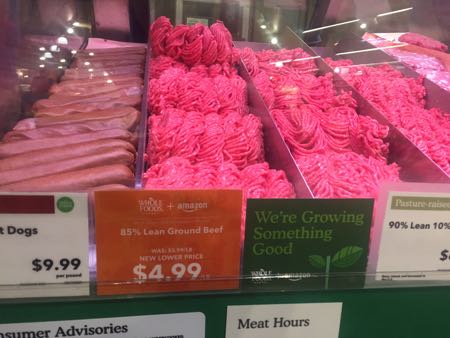This should serve as a giant flashing neon sign to the entire meat supply chain that Amazon is now in the game.
As companies prepare to compete, supply, and/or partner with Amazon, let’s look at the business model & ideology of Amazon and how it might influence their approach to the food sector.
In The Everything Store, Brad Stone chronicles Amazon’s journey. Here are a few telling quotes from Jeff Bezos, Amazon’s founder and CEO:
- “We’ll have everyday low prices and great customer experience. We’ll be Walmart and Nordstrom simultaneously.”
- “The either/or mentality that if you’re doing something good for customers it must be bad for shareholders is amateurish.”
- “There are companies that work to figure out how to charge more and companies who work to figure out how to charge less.”
For all the insights we can glean from Amazon’s past behavior, their entrance into food is already markedly different since it’s started with their largest acquisition yet ($13 billion) of physical retail. They didn’t buy Blue Apron or HelloFresh, they bought the Nordstrom of food. Can we reasonably expect Amazon to now Walmart’ize Whole Foods? Probably.

But Amazon doesn’t just sell low priced goods, they sell an entirely different business model than their competitors. According to The Everything Store, here’s how the evolution happened and the core principles that shape Amazon’s competitive advantage(s):
- Selection. They started out building the business around greater selection – you might not be able to find a book at your local bookstore but you could find any book in the world on Amazon.com.
- Customer experience. This naturally evolved to building out a better shopping experience for the customer that was easier than going to a bookstore plus the customer could make a more informed decision because of reviews and product recommendations.
- Low prices. Then Bezos bought into the idea of everyday low prices. Amazon went all in on this principle.
- Exceptional supply chain. As disruptions and inefficiencies in distribution centers (now called Fulfillment Centers) threatened Amazon’s very existence, Bezos led a laser focus to the company’s supply chain which led to sophisticated analytics, algorithms, and automation where possible.
The result of these evolutionary trends is a customer centric company that’s not afraid to innovate. They’re afraid of not innovating.
If you’ve been in the meat industry for even a second, you’ve likely heard the phrase “I’ve done it this way for 20+ years”. Companies that allow this sentiment to flourish put themselves at great risk to struggle mightily in the Amazon era.
How can you resist the temptation to continue business as usual, embrace the Amazon era and position your business to thrive?
- Check your assumptions. Are the assumptions you hold about competitors, customers, or consumers that drive your company’s behaviors still true or do they need to be updated?
- Rethink decision making processes. Are decisions made in your organization in a disciplined manner tied to objective data or someone’s gut?
- Modernize your tools. Bezos has an army of data scientists driving inefficiencies out of Fulfillment Centers and optimizing each consumer’s shopping experience. Maybe that isn’t necessary for you, but how will you leverage the rigor of analytics to make dynamic, optimized decisions?
What changes do you anticipate Amazon will drive through meat supply chain?
Curious how Amazon’s acquisition of Whole Foods could impact the entire meat supply chain? Download this white paper for insights about how Amazon dominates new segments & ways to prepare.
This article was originally published on Meatingplace.









